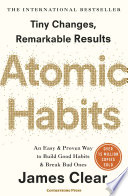

The central premise of 'Atomic Habits' is that small, incremental changes can lead to significant improvements over time. James Clear emphasizes that habits are the compound interest of self-improvement. Just as money multiplies through compound interest, the effects of your habits multiply as you repeat them. This means that even a 1% improvement each day can lead to remarkable results over time. Clear uses the analogy of an ice cube melting: at first, nothing seems to happen until you reach a critical temperature. This illustrates that the outcomes of our habits are often delayed, and we must remain patient and persistent. Small habits are also easier to integrate into our daily lives, making them more sustainable. By focusing on these tiny changes instead of drastic transformations, individuals can build a solid foundation for long-term success.
Continue readingClear introduces a framework for habit formation called the Four Laws of Behavior Change, which are: Cue, Craving, Response, and Reward. These laws serve as a blueprint for creating good habits and breaking bad ones. The first law, Cue, involves identifying triggers that initiate a habit. The second law, Craving, focuses on the desire to change, which propels us toward our goals. The third law, Response, is about the actual behavior or habit we want to adopt. Finally, the fourth law, Reward, reinforces the habit by providing a positive outcome. By understanding and manipulating these four laws, individuals can design their environment to promote good habits and discourage bad ones. This structured approach allows for a more systematic way of habit formation, making it easier to achieve desired changes.
Continue readingOne of the most profound insights from 'Atomic Habits' is the concept of identity-based habits. Clear argues that the key to lasting change is to focus on the type of person you wish to become rather than the outcomes you want to achieve. For example, instead of saying 'I want to run a marathon,' you should say 'I am a runner.' This shift in perspective helps to align your habits with your identity, making it easier to stick to them. When your habits reflect your desired identity, they become more meaningful and easier to maintain. Clear emphasizes that every action you take is a vote for the type of person you wish to be. Therefore, by consistently choosing habits that align with your desired identity, you reinforce that identity over time.
Continue readingClear highlights the significant role that environment plays in shaping our habits. He argues that our surroundings can either promote or hinder our ability to form good habits. To make good habits easier, we should design our environment to cue positive behaviors. For instance, if you want to eat healthier, keep fruits and vegetables visible and accessible in your kitchen. Conversely, to break bad habits, you should make them less convenient. By restructuring your environment, you can reduce friction for good habits and increase friction for bad ones. This idea emphasizes that we are not just products of our willpower but are heavily influenced by our surroundings. Therefore, creating an environment that supports our goals is crucial for habit formation.
Continue readingThe Two-Minute Rule is a practical strategy introduced by Clear to help individuals start new habits. The idea is to make your desired habit so easy that it takes less than two minutes to do. For example, if you want to read more books, start by reading just one page. This rule is effective because it reduces the resistance to starting a new habit. Once you begin, you often find it easier to continue. Clear suggests that the goal is not to perform the habit perfectly but to get started. By focusing on making habits small and manageable, individuals can overcome procrastination and build momentum toward larger goals. This principle is particularly useful for those who struggle with motivation or feel overwhelmed by the prospect of significant change.
Continue readingClear emphasizes the importance of tracking your habits as a means of maintaining accountability and motivation. By measuring your progress, you can see how far you've come and identify areas for improvement. This process can involve simple methods like habit trackers, journals, or apps that allow you to log your activities. Tracking not only provides a visual representation of your efforts but also reinforces the habit loop by offering immediate feedback. Clear also warns against the pitfalls of focusing solely on outcomes rather than the process. While tracking is essential, it’s important to remember that the goal is to build a sustainable system of habits rather than fixate on specific results. This balanced approach ensures that you remain engaged in the journey of self-improvement.
Continue readingThe final key idea presented in 'Atomic Habits' is the impact of community and social norms on our behaviors. Clear posits that we are influenced by the people around us, and our habits can be shaped by the groups we associate with. To cultivate good habits, it’s beneficial to surround yourself with individuals who embody the behaviors you aspire to adopt. For instance, if you want to be fit, spending time with health-conscious friends can inspire you to make better choices. Conversely, if you want to break a bad habit, distancing yourself from those who engage in that behavior can be effective. Clear underscores the importance of belonging to a community that supports your goals, as this social reinforcement can significantly enhance your commitment to habit formation.
Continue reading